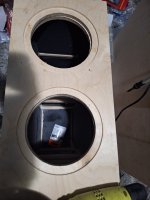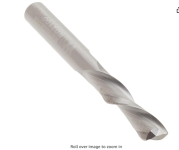I recently received some flat packs from Speaker Hardware and overall, they did a very good job.
The main issue is they didn't cut the woofer hole rebates with a big enough diameter, so the woofers will not drop in. Bottom line, I have a widen the rebates a bit. The woofer holes themselves are the correct diameter.
I understand how to do this using a jasper jig, but how do I do it without being able to create the pivot point for the jig?
They also forgot to do the round overs on the enclosure edges, but that is not a problem for me and my less than great routing skills.

The main issue is they didn't cut the woofer hole rebates with a big enough diameter, so the woofers will not drop in. Bottom line, I have a widen the rebates a bit. The woofer holes themselves are the correct diameter.
I understand how to do this using a jasper jig, but how do I do it without being able to create the pivot point for the jig?
They also forgot to do the round overs on the enclosure edges, but that is not a problem for me and my less than great routing skills.
Attachments
Last edited:
Lay out the screw holes for driver mounting. Screw a temporary thin piece of wood, plastic, whatever into those holes. Put the center/pivot point for the circle jig in the temporary filler piece.
Last edited:
I would go with @mattstat's solution. It is quite simple if you have a jasper jig.
But if you have access to a 3d printer, there is another one. You can print a round template that is 4mm wider in diameter than the recess that you want and fix it with clamps or anything on the sides, away from the router base (some tabs woill do just fine).
On second tought, if you have access do a 3d printer, you can print a piece that will fit prefectly into the current driver hole, and this piece would have the center pin for the jasper jig.... That would be easier. 😛
But if you have access to a 3d printer, there is another one. You can print a round template that is 4mm wider in diameter than the recess that you want and fix it with clamps or anything on the sides, away from the router base (some tabs woill do just fine).
On second tought, if you have access do a 3d printer, you can print a piece that will fit prefectly into the current driver hole, and this piece would have the center pin for the jasper jig.... That would be easier. 😛
Make a circular template from scrap wood that has the right diameter for your copy bit or copy ring. Clamp it on the baffle, adjust it and go! I don’t think it has to be half a millimeter precise, since the cutout probably is wide too.
[Edit dptucunduva beat me]
[Edit dptucunduva beat me]
I have hot glued a two scraps of wood to do it. One scrap spans the hole and is glued to the inside of the cabinet to bridge across the hole. The second scrap is loaded on top of the first to bring it up to the front panel level. Find the center, drill the 1/8" guide hole in the scrap bridge. To remove, flow some rubbing alcohol on the glue joints and they will weaken.
If you must work without a jig and want a neat result, go very slowly. This reduces the pressure you need to pull the tool through. Sorry if it's obvious but you may be more talented than you give yourself credit for 😉
"Rabbeting" but yes. The reason this is the correct answer is that you'll get a perfect rabbet this way. If you were to say, attempt to use another circle jig your chances of getting the center correctly located is very small. You are more likely to create a rabbet (inset) that is off center from the hole. With the rabbeting bit you only need to pick the right size bearing and set the depth correctly, and your hole and inset will be perfect.
Thanks for all the informative responses.
I already ordered a rabbeting bit with a good selection of bearings.
Not only does it look like the simplest solution, but the most accurate one also.
I already ordered a rabbeting bit with a good selection of bearings.
Not only does it look like the simplest solution, but the most accurate one also.
I found it quite game changer, and pretty cheap too given the versatility.Not only does it look like the simplest solution, but the most accurate one also.
I like the Rutlands kit. When I acquire this bit/bearing kit, it will be superior to my old method. Thanks for sharing!
My old method for dealing with a recessed rabbet hole which was slightly undersized was to use a Dremel tool with a small course-grit sanding drum. I would make a circular pass around the hole, then check for fit. Repeat as many times as necessary. It was critical to maintain a constant tool speed and pressure around the hole. I estimate each circular pass would remove about 1/4 to 1/3 of a mm. But there was always the risk of grinding a recess which was non-circular.
This bit/bearing kit is definitely better.
My old method for dealing with a recessed rabbet hole which was slightly undersized was to use a Dremel tool with a small course-grit sanding drum. I would make a circular pass around the hole, then check for fit. Repeat as many times as necessary. It was critical to maintain a constant tool speed and pressure around the hole. I estimate each circular pass would remove about 1/4 to 1/3 of a mm. But there was always the risk of grinding a recess which was non-circular.
This bit/bearing kit is definitely better.
As a bonus, the bearings can often be used with other bottom bearing bits to achieve varying offsets and profiles.
I did not know such precision bearings were available until I searched for the one MrKlinky posted. My rabbet bit is in 1/8" increments and I was wondering how it would be precise enough to widen the woofer hole. Very cool tool and thanks to @MrKlinky for posting.
Two others I found:
A cheaper one with 1/4" shaft
Here is a CMT set with a nice plastic case. (I saw it for $210 one place and $113 here, I may by this one but will research the seller if I do.)
Two others I found:
A cheaper one with 1/4" shaft
Here is a CMT set with a nice plastic case. (I saw it for $210 one place and $113 here, I may by this one but will research the seller if I do.)
Those are a good solution if the inner circle is perfect. If it's not, then the imperfections will be faithfully reproduced in the new outer circle.[photo of rabbet cutters]
- Home
- Loudspeakers
- Multi-Way
- Basic routing question

